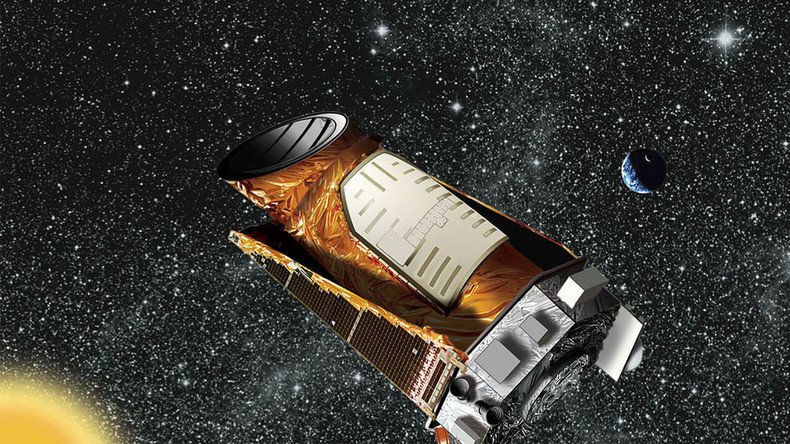Space reboot: Kepler telescope back to scanning for alien worlds

The Kepler space observatory is back on its ambitious mission in search of alien life in our galaxy, much to the relief of scientists and fans. Why the restarted NASA spacecraft slipped into emergency mode earlier this month remains a bit of a mystery.
READ MORE: NASA’s planet-hunting Kepler telescope in emergency mode
Kepler and K2 mission manager Charlie Sobeck wrote that the telescope has been rebooted and started hunting down Earth-like exoplanets in the center of Milky Way on Friday.
RT: @NASAKepler
— Kepler-440b (@Kepler440b) April 24, 2016
Today #K2mission kicks off a new campaign: searching for starless free-floating exoplanets!https://t.co/kC5ydSFdz0 …
“The pointing tables and science targets – instructions that tell the spacecraft where to look and at what – were reloaded and confirmed, onboard logs and counters were reset, and a new command sequence was created, tested and uploaded to account for the late start of the campaign,” reads NASA statement.
Kepler recovered! And, as of 8:30 a.m. PDT today, it is back on the job as the #K2Mission!https://t.co/mEAIK1b7mopic.twitter.com/ujGkhOn36d
— NASA Kepler and K2 (@NASAKepler) 22 апреля 2016 г.
While NASA engineers managed to revive the telescope, the exact cause of the glitch that disrupted the mission on April 8 is unknown.
#K2Mission begins and Kepler is found in emergency mode. pic.twitter.com/DUCmldZi4A
— Shane Barnett (@theshanebarnett) 11 апреля 2016 г.
Although, the root of the problem is still under investigation, NASA thinks the abnormality was probably triggered by “a barrage of false alarms” that overloaded the system.
Revival measures bore fruit after the telescope’s handlers rebooted some of its systems.
Meanwhile in space. https://t.co/I6EnWE5Iotpic.twitter.com/0PbYv3U698
— Geert Barentsen (@GeertHub) 11 апреля 2016 г.
The space-loving Twitter community rejoiced at the highly awaited news of the spacecraft’s full recovery.
“Hurray!! Kepler Recovered and Returned to the K2 Mission,” Tom Barclay, a Senior Research Scientist with NASA’s Kepler Mission, tweeted.
Hurray!! Kepler Recovered and Returned to the K2 Mission https://t.co/ENiVHKBelu
— Tom Barclay (@mrtommyb) 22 апреля 2016 г.
Jessica Davis offered her own explanation for the timing of the mission’s relaunch.
“Maybe the Kepler telescope is celebrating #EarthDay by continuing its mission to find another earth...” she wrote.
Maybe the Kepler telescope is celebrating #EarthDay by continuing its mission to find another earth... https://t.co/kjRxsQfW8q
— Jessica Davis (@SciCommJess) 22 апреля 2016 г.
Astro Bison is already making plans for the trove of data on exoplanets that Kepler is set to send to Earth.
“Hooray! More stars for me to set the postgrads to work on!” he tweeted.
Hooray! More stars for me to set the postgrads to work on! #K2Missionhttps://t.co/JDQQo3JVPZ
— Astro Bison (@Bison_in_space) 22 апреля 2016 г.
Others just sighed with relief and wished Kepler good luck.
Great news! You just can't keep a good spacecraft down. You're a tough one, Kepler! #K2Missionhttps://t.co/681xiRTJ7T
— Caitlin (@caitieseren) 22 апреля 2016 г.
Phew... to many more discoveries! 🎉🚀✨🌎
— Michele Johnson (@michelejohnson) 22 апреля 2016 г.
Cheers, @NASAKepler#K2Mission! pic.twitter.com/tSSBRYX5zt
Kepler found some 5,000 exoplanets during its first mission in 2012.
Since 2014, the spacecraft has been on its current K2 mission, gathering evidence of alien worlds that could support life, along with other research.
Kepler observed #Pluto during K2 Campaign 7 (out now). Here's what 100h of the Pluto data looks like! #K2Missionpic.twitter.com/lMEA0v0maI
— Geert Barentsen (@GeertHub) 21 апреля 2016 г.
NASA scientists expect to receive their first images from the restarted Kepler on May 24. The current round of observations is scheduled to end on July 1, after which it will be impossible for Kepler to survey the center of the galaxy, as it will move out of the telescope’s view.
Great news: #Kepler overcome the emergency!https://t.co/jePmlFqDYZ (IT) by @mdilorpic.twitter.com/wzIu1bXxm8
— Elisabetta Bonora (@EliBonora) 14 апреля 2016 г.
The Kepler telescope was launched in 2009, tasked with finding planets resembling Earth. It passes around the sun at a distance of some 75 million miles (120 million km).













